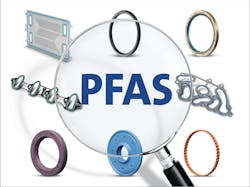PFAS Regulations: The Impacts for Fluid Power and Electromechanical Systems
The U.S. and Europe are implementing regulations related to the family of per- and polyfluoroalkyl substances (PFAS) utilized in a range of products. They are considered forever chemicals because they do not break down easily and can therefore cause harm to humans and the environment by getting into waterways, soil and more.
On April 10, 2024, the U.S. Environmental Protection Agency (EPA) announced the final National Primary Drinking Water Regulation (NPDWR) for six PFAS to limit how much of these substances can be present in public drinking water. In addition, the EPA has established a rule requiring manufacturers to report use of PFAS (see sidebar below).
Meanwhile in Europe, the European Chemicals Agency (ECHA) published a proposal on February 7, 2023, for a comprehensive PFAS ban. This legislation is still under review, but current projected timelines show it could be enforced as soon as the end of the decade.
Read these articles from Endeavor Business Media partner site WaterWorld and Wastewater Digest to learn more about the U.S. PFAS regulations.
How PFAS came to be regulated by U.S. EPA
EPA announces final PFAS Maximum Contaminant Levels (MCL)
How CERCLA’s PFOA, PFOS designation could impact wastewater treatment
While these regulations will benefit the environment, meeting them will be challenging for manufacturers in a range of industries — including those in the fluid power and electromechanical motion control sector — due to the widespread use of PFAS and the time it will take to develop appropriate alternatives.
The Challenges Posed by PFAS Regulations
In response to the proposed European legislation, HAWE Hydraulik and Freudenberg Sealing Technologies noted the prominence of PFAS compounds, particularly fluoropolymers, in many components such as seals, cables and lines, coatings, electronic components, corrosion inhibitors, compressors, motors and hydraulics.
HAWE said in a statement it released related to the blanket ban on PFAS that “the physical and chemical properties of these materials allow our products to withstand various technical parameters, such as high temperatures and wear resistance.”
Freudenberg added that fluoropolymers are often the “material of choice” when seals must meet multiple requirements — such as excellent high-temperature resistance, lubricant compatibility, or complying with stringent standards for material with food contact.
“We support the goals of the European Green Deal and the Chemicals Strategy for Sustainability, but are calling for a differentiated, risk-based approach to chemical regulation than is planned for PFAS,” said Dr. Ruth Bieringer, Vice President of Technology & Innovation at Freudenberg, in a press release discussing the results of a study conducted by the company and Germany-based research organization Fraunhofer on the impact of a potential PFAS ban.
Developing alternative options which meet the same performance requirements as PFAS-based technologies will take time. And as Nancy Getz, Global Product Line Director at Trelleborg Sealing Solutions said in an interview with Power & Motion, there are some performance advantages that customers might sacrifice with PFAS-free alternatives such as the low friction properties achieved with PTFE (polytetrafluoroethylene, a commonly used type of fluoropolymer).
“A different material may cause a product to wear faster, reduce its operating temperature range or have less material compatibility than its fluoropolymer counterpart,” she said. “That’s why it’s important for customers to engage with us to find the best material for their application.”
She went on to say that Trelleborg is proactively contributing to the development of effective regulatory change. “Simplistic ‘one size fits all’ regulations would be problematic as fluoropolymers’ unique attributes mean that they will not be replaced by a single ‘magic bullet’ material; alternatives will need to be developed as ‘premier’ application-specific solutions.
“New regulations related to PFAS need to be differentiated by application because for some materials in demanding environments more time will be needed to develop effective new solutions,” she said.
In a webinar co-hosted by Assent Inc. — a provider of supply chain sustainability management solutions — and the Association of Equipment Manufacturers (AEM), Jason Malcore, Senior Director, Safety & Product Leadership at AEM, said there are not viable replacements for many of the PFAS chemistries currently used by OEMs and their component suppliers.
“Now the components you’re going to use, the equipment you’re going to build, is not going to have the [same] critical functionalities,” he said. “This could result in a number of things. If you’re using sealing technology and hydraulics, you could have a loss of pressure which means massive safety concerns, damage to the machine, severe performance [and] quality problems.”
READ MORE: The Right Seal Reduces Contamination in Hydraulic Systems
Differentiation Between Regulations
Governments at all levels — city, state and national — are looking to regulate the use of PFAS because of their environmental impact. However, this means there is also differentiation between some of the regulations which can be challenging to monitor and design products to meet.
As Cally Edgren, Vice President, Sustainability at Assent Inc., noted during the webinar with AEM, PTFE is in the scope of some regulations but not others. “That’s where understanding the regulations is actually quite critical,” she said.
Malcore added that the sheer number of different emerging PFAS regulations that are coming into play are also adding compliance costs for manufacturers. “It means [they have to] spend more money trying to understand what the rule is, collect different forms of data, [and] perform different activities to meet the requirement in whichever jurisdiction [they're] trying to sell into.”
AEM and other global construction equipment industry associations co-signed a worldwide Declaration on PFAS restrictions in May 2024. In it the associations discuss the importance of these chemicals to the sector due to their use in critical components and systems, offering the following examples:
- Coatings and Seals: O-rings, gaskets and seals prevent fluid leaks as well as contamination of internal systems from water, dirt, dust and debris. Coatings protect the machine surfaces from premature deterioration, extending machine lifetime.
- Cables and hoses: Cables and hoses transfer fluids and prevent leaks.
- Hydraulic systems: PFAS is an additive in hydraulic fluids and lubricants.
- Refrigerants: The industry utilizes two PFAS compounds, HFC-134a and HFO-1234yf, in their air conditioning systems to satisfy various health and safety requirements.
- Alternative Power Technologies: PFAS provides the functional properties that are essential for many new alternative power technologies, including batteries and hydrogen fuel cells.
The associations say broad restrictions on PFAS could be harmful to the industry and its supply chain by impacting safety, durability and environmental compliance. Instead, they believe regulations should be “focused on high-risk PFAS, emphasizing prevention of chemical release, proper waste management, and recycling.” Harmonized global definitions and sufficient transition periods would be a better approach as well to benefit both the goals of the regulations and manufacturers’ ability to comply with them.
Authors of the study “Replacement of Polymeric PFAS in Industrial Applications with Harsh Environments,” conducted by Freudenberg and Fraunhofer concluded that a full replacement of PFAS in the sealing industry is not currently feasible without negatively impacting material properties, performance, and product longevity. They instead are advocating for a differentiated and fact-based discussion because of the diversity of the over 10,000 PFAS compounds found in the market today.
“From our perspective, assessing the life cycle of fluoropolymers, which are considered ‘polymers of low concern’, is a credible method for realistically evaluating potential risks to human health and the environment,” said Dr. Raimund Jaeger, Head of the Tribology Business Unit at Fraunhofer IWM in Freudenberg’s press release announcing the release of the study. “All stakeholders involved in this study agree that the safe production and disposal of polymeric PFAS is crucial. As long as precautions are taken to avoid harmful environmental impacts, the continued industrial use of fluoropolymers should remain possible.”
HAWE noted in its statement that the fluoropolymers it uses meet the criteria for “Polymer of Low Concern” which means they are considered non-toxic, non-bioavailable and non-water soluble.
READ MORE: Seals contain fluid to pressures well above 4000 psi
Development of PFAS Alternatives Spurring Innovation and Sustainability
Despite the challenges, that does not mean companies are not making efforts to reduce their use of PFAS. In early March 2024, igus announced its chainflex cables are now manufactured without PTFE or PFAS chemicals. Additionally, the company is assuring that it is using PFAS-free materials in 95% of its chainflex cables.
As the European Union and other regions assess their PFAS regulations, igus wanted to assure customers of the compliance of its products should a ban take place as well as take another step in its own sustainability journey.
Getz said sustainability and compliance are important areas of focus for Trelleborg. As such, the company is working to find alternative solutions to meet various customer requirements and aims to be PFAS surfactant-free by the end of 2025 at the latest.
“This is an ambitious target to achieve for every material group; for example, for fluoroelastomers (FFKMs) this may not be realistic, but we need to move as quickly as possible,” she said.
She said some of the solutions Trelleborg currently offers include:
- Various existing alternative compounds that cover a broad range of application replacement qualities. These include PU, ultra-high molecular weight polyethylene (UHMWPE), Polyether Ether Ketone (PEEK), high-performance plastics (HPP) and thermoplastic elastomers (TPE) for some suitable applications.
- Alternative sealing configurations which when paired with non-fluorinated materials can also reduce the need to use PFAS materials.
- Utilizing the company’s polymer R&D capabilities to develop entirely new solutions that can meet challenging application requirements.
“PFAS regulations are spurring innovation and conversations about what is truly possible,” said Getz. “We continue to look at our portfolio of materials and see what properties we can leverage and how better performance can be achieved by pairing an alternative material with the right design.”
She also noted that in addition to PFAS, there are other regulatory changes which could impact the performance of sealing systems. “A lot is possible when you change a seal’s geometry and pair it with the right material, but customers must talk to us about their needs before making decisions about transitioning to alternative products and materials.”
Additionally, she said it is important for customers to remember that new regulations relating to PFAS in fluoropolymers have not been finalized. “While we do recognize the importance of and are proactively identifying alternative solutions, PFAS surfactant-free PTFE may continue to be a viable solution into the foreseeable future,” she said.
Getz concluded by saying, “We don’t want to create waste. If you put PTFE in a landfill, it’s there forever. In the future we want to take production residues and end-of-life materials and give them new value. We work hard to find ways to reuse it in our products or in other demanding applications.
“We know customers are also interested in reducing waste but it’s going to take commitment on both sides. We want to work with customers and say, ‘We know you have requirements to reduce waste and increase circularity. How can we partner up to achieve those objectives?’ We will not compromise on performance, reliability or value of our products and materials.”
READ MORE: How FFKM Elastomers Benefit Critical Applications
Manufacturers to Report Use of PFAS Starting in 2025
The U.S Environmental Protection Agency (EPA) established a reporting rule in October 2023 that requires those who manufactured or imported Per- and Polyfluoroalkyl Substances (PFAS) as well as products containing the substance between January 1, 2011, and January 1, 2023, to submit information on their use of PFAS to the EPA.
Manufacturers are being asked to submit information related to chemical identities, production volumes, industrial uses, commercial and consumer uses, worker exposures, disposal, and any existing information related to potential environmental and health effects.
Initially, reporting was to begin November 12, 2024, but on September 5 the EPA extended the reporting timeframe due to budget constraints which impacted development of its reporting software. Reporting is now scheduled to begin in July 2025. During this extension period the EPA will seek more feedback from the industry on the necessary reporting and its Central Data Exchange (CDX) system through which the information will be submitted.
Organizations such as the Association of Equipment Manufacturers (AEM) and National Association of Manufacturers (NAM) note the extended reporting timeframe is beneficial for the industry as it provides more time to fully understand and collect the required information.
About the Author
Sara Jensen
Executive Editor, Power & Motion
Sara Jensen is executive editor of Power & Motion, directing expanded coverage into the modern fluid power space, as well as mechatronic and smart technologies. She has over 15 years of publishing experience. Prior to Power & Motion she spent 11 years with a trade publication for engineers of heavy-duty equipment, the last 3 of which were as the editor and brand lead. Over the course of her time in the B2B industry, Sara has gained an extensive knowledge of various heavy-duty equipment industries — including construction, agriculture, mining and on-road trucks —along with the systems and market trends which impact them such as fluid power and electronic motion control technologies.
You can follow Sara and Power & Motion via the following social media handles:
X (formerly Twitter): @TechnlgyEditor and @PowerMotionTech
LinkedIn: @SaraJensen and @Power&Motion
Facebook: @PowerMotionTech

Leaders relevant to this article:





